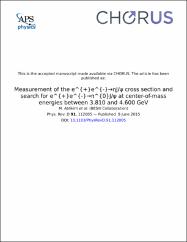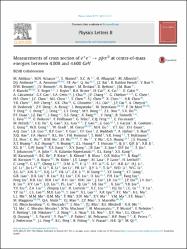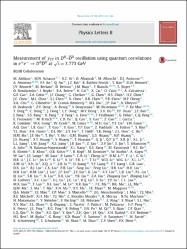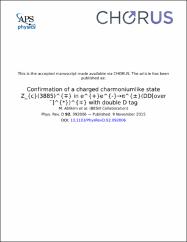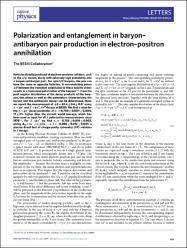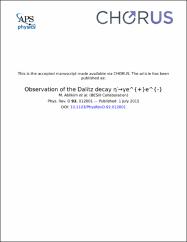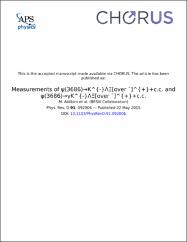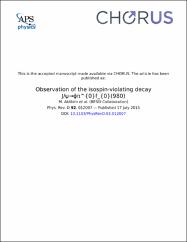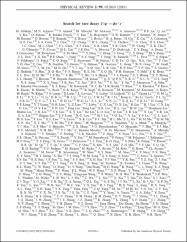Ara
Toplam kayıt 42, listelenen: 31-40
Measurement of the e+e- ??J /? cross section and search for e+e- ??0J /? at center-of-mass energies between 3.810 and 4.600 GeV
(American Physical Society, 2015)
Using data samples collected with the BESIII detector operating at the BEPCII collider at 17 center-of-mass energies from 3.810 to 4.600 GeV, we perform a study of e+e-??J/? and ?0J/?. The Born cross sections of these two ...
Measurements of cross section of e+e??pp¯?0 at center-of-mass energies between 4.008 and 4.600 GeV
(Elsevier B.V., 2017)
Based on e+e? annihilation data samples collected with the BESIII detector at the BEPCII collider at 13 center-of-mass energies from 4.008 to 4.600 GeV, measurements of the Born cross section of e+e??pp¯?0 are performed. ...
Measurement of yCP in D0-D0 oscillation using quantum correlations in e+e- ? D0D0 at ?s = 3.773 GeV
(Elsevier B.V., 2015)
We report a measurement of the parameter yCP in D0-D-0 oscillations performed by taking advantage of quantum coherence between pairs of D0D-0 mesons produced in e+e- annihilations near threshold. In this work, doubly-tagged ...
Confirmation of a charged charmoniumlike state Zc (3885)? in e+e- ??± (D D ¯ ?)? with double D tag
(American Physical Society, 2015)
We present a study of the process e+e-??±(DD¯?)? using data samples of 1092 pb-1 at s=4.23 GeV and 826 pb-1 at s=4.26 GeV collected with the BESIII detector at the BEPCII storage ring. With full reconstruction of the D ...
Polarization and entanglement in baryon–antibaryon pair production in electron–positron annihilation
(Nature Publishing Group, 2019)
Particles directly produced at electron–positron colliders, such as the J/? meson, decay with relatively high probability into a baryon–antibaryon pair1. For spin-1/2 baryons, the pair can have the same or opposite helicites. ...
Observation of the dalitz decay ?’??e+e?
(American Physical Society, 2015)
We report the first observation of the Dalitz decay ?’??e+e?, based on a data sample of 1.31 billion J/? events collected with the BESIII detector. The ?’ mesons are produced via the J/????’ decay process. The ratio ...
Measurements of ? (3686) ?k- ? ? ¯ ++ c. c. and ? (3686) ??K- ? ? ¯ ++ c. c.
(American Physical Society, 2015)
Using a sample of 1.06×108?(3686) events produced in e+e- collisions at s=3.686 GeV and collected with the BESIII detector at the BEPCII collider, we present studies of the decays ?(3686)?K-??¯++c.c. and ?(3686)??K-??¯++c.c.. ...
Observation of the isospin-violating decay J /? ???0f0 (980)
(American Physical Society, 2015)
Using a sample of 1.31×109 J/? events collected with the BESIII detector at the BEPCII collider, the decays J/????+?-?0 and J/????0?0?0 are investigated. The isospin-violating decay J/????0f0(980) with f0(980)??? is observed ...
Search for hc ??+?-J /? via ? (3686) ??0?+?-J /?
(American Physical Society, 2018)
Using a data sample of 448.1×106 ?(3686) events collected with the BESIII detector operating at the BEPCII, we perform search for the hadronic transition hc??+?-J/? via ?(3686)??0hc. No signals of the transition are observed, ...
Search for rare decay J /? ??e+e-
(American Physical Society, 2019)
Using a data sample of 448.1×106 ?(3686) events collected at s=3.686 GeV with the BESIII detector at the Beijing Electron-Positron Collider II, we search for the rare decay J/???e+e- via ?(3686)??+?-J/?. No signal events ...

